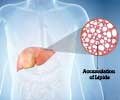NPC1 affects about one in every 120,000 children globally and results in abnormal cholesterol accumulation, progressive neurodegeneration and death.

‘A nanotech-based delivery system has the potential to carry the new drug into cells far more effectively, improve its efficacy by about five times, and allow use of much lower doses that may still help treat NPC1 without causing such severe hearing loss.’





However, a compound that shows promise is now undergoing clinical trials, but it has major drawbacks - the high doses necessary also cause significant hearing loss and lung damage, as well as requiring direct brain injection. The same system, they say, may ultimately show similar benefits for 50 or more other genetic disorders, especially those that require "brain targeting" of treatments.
"Right now there's nothing that can be done for patients with this disease, and the median survival time is 20 years," said Gaurav Sahay, an assistant professor in the Oregon State University/Oregon Health & Science University College of Pharmacy, and corresponding author on the new study.
"The new cholesterol-scavenging drug proposed to treat this disorder, called cyclodextrin may for the first time offer a real treatment. But it can cause significant hearing loss and requires multiple injections directly into the brain, which can be very traumatic. I'm very excited about the potential of our new drug delivery system to address these problems."
In this approach, the HPβCD drug is attached to an extraordinarily small, nanotech-sized lipid particle that can carry it into cells, where it helps to flush out cholesterol. Researchers were surprised to discover, however, that the carrier itself also helped address the problem, while working in synergy with the drug it carries to greatly increase its effectiveness.
Advertisement
In previous research with the HPβCD drug in animal models, the treatment did slow the progression of this disease, but did not reverse it. The disease focuses its damage on liver and brain cells.
Advertisement
The researchers have also partnered with Dr. Edward Neuwelt at the OHSU Blood Brain Barrier Program, who has pioneered temporary opening of the blood brain barrier in humans to access drugs to the brain.
"Taken together, nanocarriers can serve as a platform that can effectively deliver small molecules, genes and perhaps imaging agents for treatment and diagnosis of a wide variety of other rare lysosomal storage disorders," the researchers wrote in their conclusion.
Source-Eurekalert















